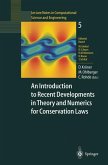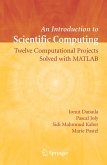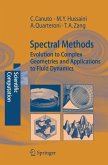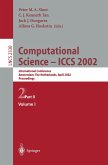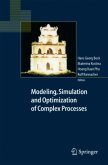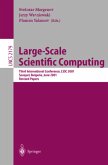The target audience of this book is students and researchers in computational sciences who need to develop computer codes for solving partial differential equations. The exposition is focused on numerics and software related to mathematical models in solid and fluid mechanics. The book teaches finite element methods, and basic finite difference methods from a computational point of view. The main emphasis regards development of flexible computer programs, using the numerical library Diffpack. The application of Diffpack is explained in detail for problems including model equations in applied mathematics, heat transfer, elasticity, and viscous fluid flow. Diffpack is a modern software development environment based on C++ and object-oriented programming. All the program examples, as well as a test version of Diffpack, are available for free over the Internet.
The second edition features lots of improvements and new material. The most significant additions include - finite difference methods and implementations for a 1D time-dependent heat equation (Chapter 1. 7. 6), - a solver for vibration of elastic structures (Chapter 5. 1. 6), - a step-by-step instruction of how to develop and test Diffpack programs for a physical application (Chapters 3. 6 and 3. 13), - construction of non-trivial grids using super elements (Chapters 3. 5. 4, 3. 6. 4, and 3. 13. 4), - additional material on local mesh refinements (Chapter 3. 7), - coupling of Diffpack with other types of software (Appendix B. 3) - high-level programming offinite difference solvers utilizing the new stencil (finite difference operator) concept in Diffpack (Appendix D. 8). Many of the examples, projects, and exercises from the first edition have been revised and improved. Some new exercises and projects have also been added. A hopefully very useful new feature is the compact overview of all the program examples in the book and the associated software files, presented in Chapter 1. 2. Errors have been corrected, many explanations have been extended, and the text has been upgraded to be compatible with Diffpack version 4. 0. The major difficulty when developing programs for numerical solution of partial differential equations is to debug and verify the implementation. This requires an interplay between understanding the mathematical model,the in volved numerics, and the programming tools.
The second edition features lots of improvements and new material. The most significant additions include - finite difference methods and implementations for a 1D time-dependent heat equation (Chapter 1. 7. 6), - a solver for vibration of elastic structures (Chapter 5. 1. 6), - a step-by-step instruction of how to develop and test Diffpack programs for a physical application (Chapters 3. 6 and 3. 13), - construction of non-trivial grids using super elements (Chapters 3. 5. 4, 3. 6. 4, and 3. 13. 4), - additional material on local mesh refinements (Chapter 3. 7), - coupling of Diffpack with other types of software (Appendix B. 3) - high-level programming offinite difference solvers utilizing the new stencil (finite difference operator) concept in Diffpack (Appendix D. 8). Many of the examples, projects, and exercises from the first edition have been revised and improved. Some new exercises and projects have also been added. A hopefully very useful new feature is the compact overview of all the program examples in the book and the associated software files, presented in Chapter 1. 2. Errors have been corrected, many explanations have been extended, and the text has been upgraded to be compatible with Diffpack version 4. 0. The major difficulty when developing programs for numerical solution of partial differential equations is to debug and verify the implementation. This requires an interplay between understanding the mathematical model,the in volved numerics, and the programming tools.
From the reviews of the second edition:
"The aim of this book, as stated in the preface is 'To Teach Numerics along with Diffpack'. ... I feel that the author has been successful with the stated aim, and the content is well directed to the target audience ... . This book will be very useful ... for graduate students or researchers, who intend working with DIFFPACK. It provides an excellent advanced tutorial and users manual for DIFFPACK, while also providing a wealth of first hand computational experience presented by an excellent computational scientist." (Stephen Roberts, gazette The Australian Mathematical Society, Vol. 32 (5), 2005)
"The present book can be considered to be a sort of handbook for Diffpack, yet it is more than just that. ... No one planning to use Diffpack is likely not to benefit from this presentation." (H. Muthsam, Monatshefte für Mathematik, Vol. 143 (4), 2004)
"The present version improves and corrects the text, adds new material, and updates the book to match the version 4.0 of the C++ software package Diffpack. ... this is a very useful book for the users of Diffpack. However, this book deserves a wider readership than the users of Diffpack, because it provides valuable insights of object oriented numerics and state-of-the-art program development using standard tools for numerical programming, data visualization, and scripting techniques based on Perl." (Matti Vuorinen, Zentralblatt MATH, Vol. 1037 (12), 2004)
"This large monograph ... is devoted to an updated presentation of the most important numerical techniques for solving partial differential equations using the software Diffpack Programming. ... Many figures and tables make explanation much more easier, in addition a collection of examples are discussed with many details. ... In addition a complete bibliography and full index is added. In conclusion this book will be certainly very helpful to everybody involving in numericalsimulations and having Diffpack software." (Stéphane Métens, Physicalia, Vol. 26 (1), 2004)
"This is the second edition of a popular tutorial on the numerical solution of partial differential equations (PDEs). ... has over 150 exercises and a comparable number of worked-out examples together with computational code. There is an extensive bibliography of 156 references for further reading. ... it should be of interest and use to researchers and practitioners working in computational mechanics and to students aspiring to enter that field. It should make a good text for graduate-level numeric courses. Purchase by libraries is recommended." (RL Huston, Applied Mechanics Reviews, Vol. 56 (6), 2003)
"The aim of this book, as stated in the preface is 'To Teach Numerics along with Diffpack'. ... I feel that the author has been successful with the stated aim, and the content is well directed to the target audience ... . This book will be very useful ... for graduate students or researchers, who intend working with DIFFPACK. It provides an excellent advanced tutorial and users manual for DIFFPACK, while also providing a wealth of first hand computational experience presented by an excellent computational scientist." (Stephen Roberts, gazette The Australian Mathematical Society, Vol. 32 (5), 2005)
"The present book can be considered to be a sort of handbook for Diffpack, yet it is more than just that. ... No one planning to use Diffpack is likely not to benefit from this presentation." (H. Muthsam, Monatshefte für Mathematik, Vol. 143 (4), 2004)
"The present version improves and corrects the text, adds new material, and updates the book to match the version 4.0 of the C++ software package Diffpack. ... this is a very useful book for the users of Diffpack. However, this book deserves a wider readership than the users of Diffpack, because it provides valuable insights of object oriented numerics and state-of-the-art program development using standard tools for numerical programming, data visualization, and scripting techniques based on Perl." (Matti Vuorinen, Zentralblatt MATH, Vol. 1037 (12), 2004)
"This large monograph ... is devoted to an updated presentation of the most important numerical techniques for solving partial differential equations using the software Diffpack Programming. ... Many figures and tables make explanation much more easier, in addition a collection of examples are discussed with many details. ... In addition a complete bibliography and full index is added. In conclusion this book will be certainly very helpful to everybody involving in numericalsimulations and having Diffpack software." (Stéphane Métens, Physicalia, Vol. 26 (1), 2004)
"This is the second edition of a popular tutorial on the numerical solution of partial differential equations (PDEs). ... has over 150 exercises and a comparable number of worked-out examples together with computational code. There is an extensive bibliography of 156 references for further reading. ... it should be of interest and use to researchers and practitioners working in computational mechanics and to students aspiring to enter that field. It should make a good text for graduate-level numeric courses. Purchase by libraries is recommended." (RL Huston, Applied Mechanics Reviews, Vol. 56 (6), 2003)


